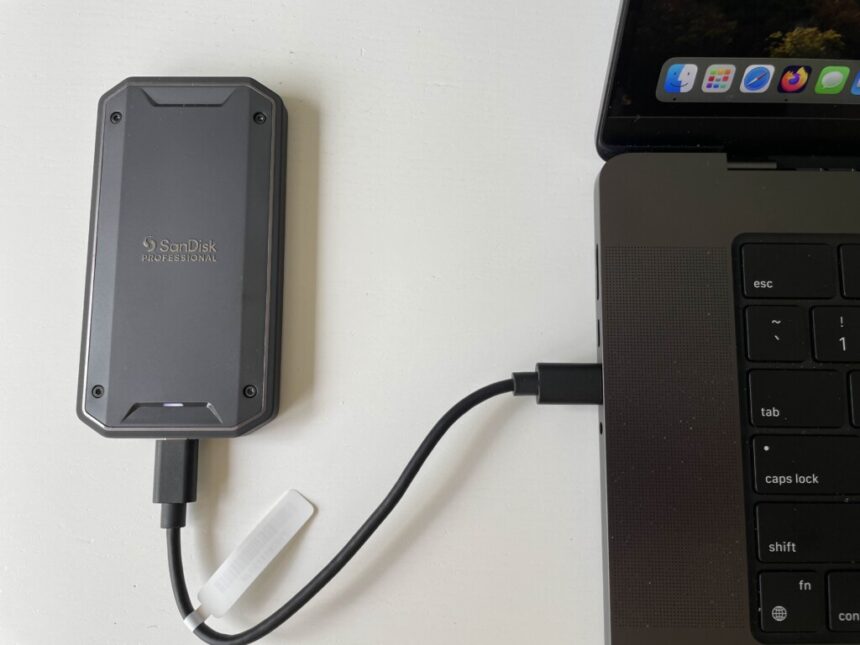Hey, you tech lovers! Your favorite digital guru is back with another in-depth look at the Mac ecosystem. Today we’re going to talk about something that may seem simple but is very important for keeping your files organized and your workflow running smoothly: How to format an external hard drive for your Mac
The first and most important thing you need to do is format your new or old external hard drive for your Mac. Believe me, putting in some work up front can save you a lot of trouble, lost data, and problems with compatibility later on.
We’ll show you everything you need to know in this complete guide. You will quickly become an expert at formatting external hard drives for your Mac. You will learn about file systems, get step-by-step instructions, and get useful tips.
Why Formatting Matters: Getting Ready for Success
Formatting an external hard drive is like getting a blank canvas ready. You need to prepare the surface before you can start painting your masterpiece, which in this case is saving your important data. Formatting basically wipes out all of the data that is already there and sets up a file system that your Mac can read and use to organize files.
File systems are not the same for all operating systems. For example, Windows usually uses NTFS or exFAT, while macOS mostly uses APFS or HFS+. If you plug in a drive that is formatted for Windows into your Mac, it might only be able to read it or, even worse, it might not work at all. Formatting makes sure that your external hard drive and your Mac can understand each other, which lets you read and write files without any problems.
The main benefits of formatting your Mac are:
Compatibility: Makes sure the external hard drive works perfectly with your Mac.
Performance: Makes the drive work better with macOS, which could speed up reading and writing.
Clean Slate: Deletes all data on the drive, including any malware or corrupted files that may be there. * Partitioning (Optional): Lets you break up your drive into several virtual volumes for better organization.
Choosing the Right Language for File Systems
Before you start formatting, you need to know about the different file systems that are available on macOS and pick the one that works best for you. These are the most common choices you’ll see:
APFS (Apple File System): Apple made this the default file system for macOS High Sierra and later. It works best for speed, security, and reliability, especially when using solid-state drives (SSDs). Source: Apple Support—About APFS
When to Choose APFS: If you plan to mostly use your external hard drive with Macs running macOS High Sierra or later, especially if it’s an SSD, APFS is usually the best choice.
HFS+ (Mac OS Extended): This was the main file system used by macOS before High Sierra. It is also known as HFS Extended Journaled. It is still a good choice for older Macs.
When to Choose HFS+: If you need to use the external hard drive with older Macs running macOS Sierra or earlier, or if you want the best compatibility with Time Machine on older macOS versions.
exFAT (Extended File Allocation Table): This file system works well with both Windows and macOS. If you often need to share the external hard drive between a Mac and a PC, this is a good choice.
When to Choose exFAT: If you need to use the external hard drive with both Mac and Windows computers on a regular basis and don’t want to worry about file size limits (like FAT32). [Backlink: Link to a blog post that explains how macOS and Windows file systems work together]
FAT32 (File Allocation Table 32): This is an older file system that works with a lot of different systems, but it has some big problems, like a maximum file size of 4GB. Unless you really need to be able to work with very old systems, it’s not a good idea to use it these days.
When to Choose FAT32: Only if you need to use very old operating systems or devices that don’t support exFAT. Know that the file size limit is 4GB.
Pro Tip: Think about what you will mainly use your external hard drive for. APFS or HFS+ are the best choices if you only want to use it to back up your Mac with Time Machine. exFAT is the best way to move big files between Macs and PCs.
How to Format Your External Hard Drive on a Mac in Steps
Now it’s time to get to work. This is a step-by-step guide for formatting your external hard drive on your Mac using Disk Utility:
Connect Your External Hard Drive: Connect your external hard drive to a USB or Thunderbolt port on your Mac that is free.
Start Disk Utility: You can find Disk Utility in the /Applications/Utilities folder or by typing “Disk Utility” into Spotlight search (Command + Spacebar).
Choose Your External Hard Drive: You can see a list of all the storage devices that are connected to your computer in the Disk Utility window’s left sidebar. Find your external hard drive. It will usually be in the “External” section. Click on the name of the drive itself, not the volume that is listed below it.
Click the “Erase” Button: After choosing your external hard drive, click the “Erase” button in the toolbar at the top of the Disk Utility window.
Set up the options for erasing: A dialog box will pop up, asking you to set up the formatting options:
Name: Give your external hard drive a name that describes it. This is the name that will show up in Finder.
Format: You can choose the file system here. Choose the right option for you from APFS, HFS+, exFAT, or FAT32.
Scheme (for advanced users): Most people should use the default “GUID Partition Map” scheme. This makes sure that it works with macOS.
Click “Erase”: After you’ve set the name, format, and scheme, double-check your choices and then click the “Erase” button.
Confirmation: Disk Utility will let you know that this process will delete everything on the external hard drive. Click “Erase” again if you’re sure you want to go through with it.
Let the Process Finish: Depending on the size and speed of your external hard drive, the formatting process could take anywhere from a few seconds to a few minutes. You will see a bar that shows how far along you are.
Click “Done”: You’ll see a message that says “Operation successful” when the formatting is done. Press “Done.”
Your external hard drive is now ready to use with your Mac!
Useful Advice and Best Practices for Mac External Hard Drives
Formatting is only the first step. Here are some useful tips for getting the most out of your external hard drive with your Mac:
Time Machine for Regular Backups: If you chose APFS or HFS+, you might want to use your external hard drive as a dedicated backup drive with Time Machine, which is macOS’s built-in backup tool. Source: Apple Support—Use Time Machine to back up your Mac This is very important for keeping your important data safe.
Safely Eject Your Drive: Always remember to safely eject your external hard drive before you unplug it from your Mac. To remove the drive, either drag its icon from your desktop to the Trash (which turns into an Eject icon) or right-click on it in Finder and choose “Eject.” If you don’t do this, your data could become corrupted.
Think about partitioning for organization: If you have a big external hard drive, you might want to split it up into several volumes. For instance, having separateen partitions for backups, media files, and documents can help you better organize your data. When formatting, you can do this in Disk Utility by clicking “Partition” instead of “Erase.”
Clearly Label Your Drives: Give your external hard drives names that describe what they do so you can easily tell them apart, especially if you have more than one.
Check for mistakes every so often: Check your external hard drive for errors every now and then with Disk Utility’s “First Aid” feature. In Disk Utility, choose the drive and click “First Aid” in the toolbar.
Physical Security: Take good care of your external hard drive. Do not drop it or leave it in very hot or cold weather or in water.
Encrypting Sensitive Data: Use FileVault, which is built into macOS, to encrypt your external hard drive if it has sensitive information on it. To turn on FileVault for external drives in the Finder, right-click on the drive and choose “Encrypt [Drive Name].”
How to Use It: Incorporate the habit of backing up your Mac to your formatted external hard drive at least once a week. Set a reminder on your calendar!
Fixing common formatting problems
Formatting is usually pretty easy, but you might run into problems from time to time. Here are some common problems and how to fix them:
Disk Utility Not Recognizing the Drive: Make sure the external hard drive is plugged in correctly and that the cable is working. Use a different USB port. If the drive still doesn’t show up, there may be a problem with the hardware.
“Erase” Option is Grayed Out: Make sure you choose the main drive entry in the Disk Utility sidebar and not a volume below it.
Formatting is stuck or taking too long: This could mean that the external hard drive is broken. If you want to check for errors, try canceling the operation and running “First Aid.” The drive might be failing if the errors can’t be fixed.
Can’t Write to the Drive After Formatting: Make sure you chose the right file system. If you formatted it as NTFS, your Mac can usually only read from it without any extra software. If you need to read and write on both Mac and Windows, reformat it as exFAT.
Mastering External Storage on Your Mac
Formatting your external hard drive for your Mac is a basic skill that lets you take control of your digital life. You can make sure that your valuable data is safe, works well, and is compatible with other systems by learning about file systems, following the right steps, and using best practices.
So, plug in that external hard drive, open Disk Utility, and take charge of your storage! With what you learned today, you can handle any storage problem and keep your Mac running well.
https://afriteacher.com/category/trends

